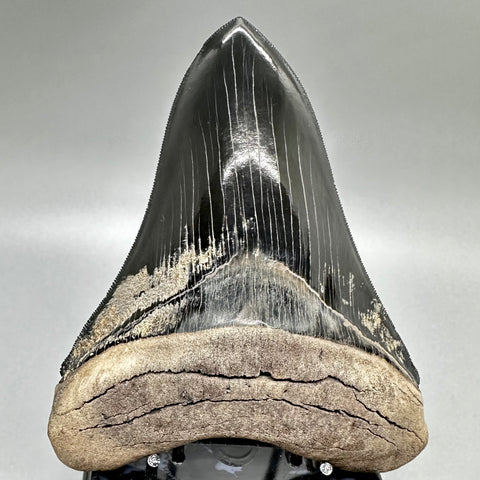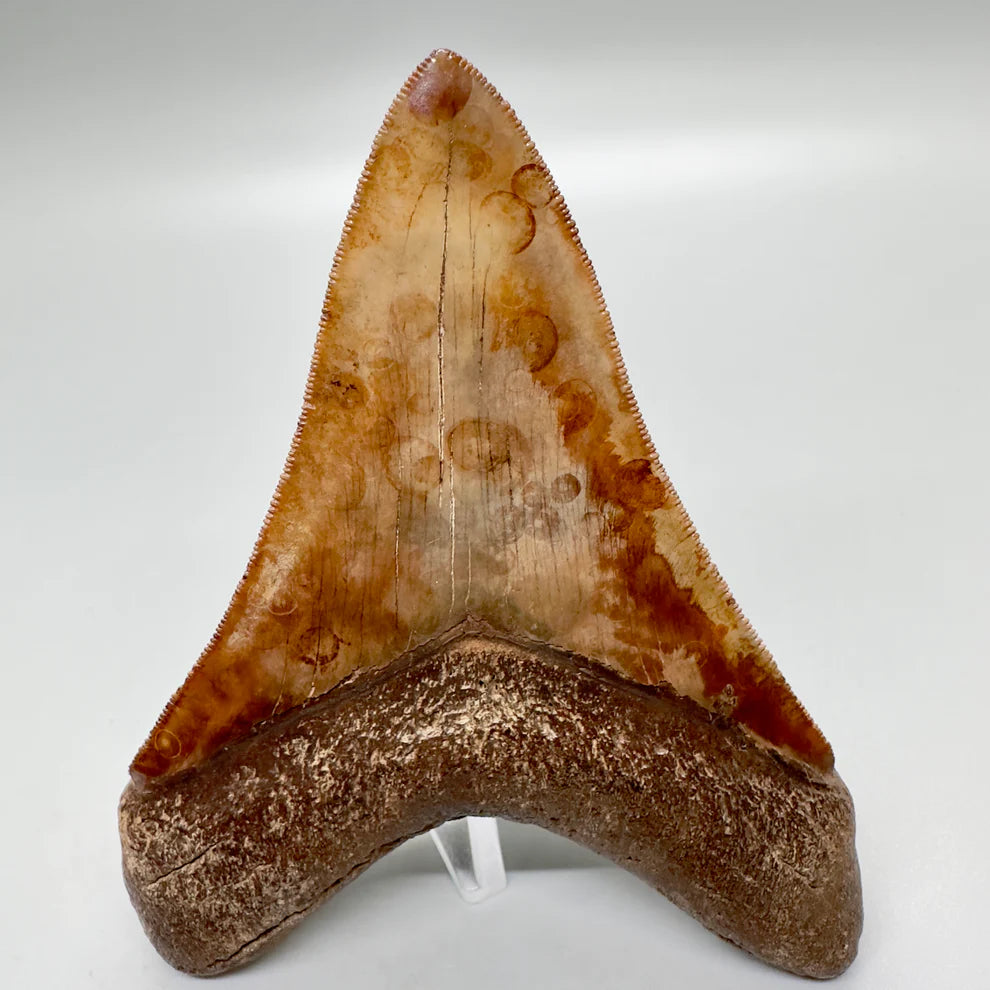Introduction
This is an article I wrote back in 1998 (published in a fossil magazine called Prehistoric Times) about the megalodon shark. Only minor updates have been given but one thing we have not changed is the scientific name. We still believe "Carcharocles" to be the more fitting genus for megalodon rather than the currently described "Otodus". We will cover this topic in detail in a future blog post. We hope you enjoy the read!
The Ancient Encounter
Imagine a shark three times the size of the modern Great White shark charging with reckless abandon into a pod of enormous 30 foot Sperm Whales. The mighty fish opens its gaping jaws and crunches into the side of one of the swimming mammals, slicing through flesh, blubber, ribs, and vertebrae. A single 6” long ivory-white tooth is pried loose from the shark’s lower jaw and flutters down to the bottom of the ocean, stained red from the assault. The tooth hits the bottom and soon settles down in the soft mud. The tooth is slowly covered by the sediment until it is deep enough where it is cut off from the water and any oxygen that might creep through. Ten million years later a diver probes into the bottom of a relatively modern river and uncovers this magnificent tooth, now brown from the minerals that have penetrated it over the years. This tooth, now a fossil but almost as sharp as the day it was lost, becomes a prized possession for the lucky finder who hurries up to the boat to show his friends.
This tooth is, of course, from the largest predator to ever inhabit the world’s
oceans - Carcharocles megalodon. This ancient story relives itself day after day all over the world. Evidence of the megalodon shark can be found in fossilized teeth and vertebrae (even fossilized whale bones still showing bite marks from the attack) all over the world. The broad stratigraphic range of this shark (Eastern United States, Pacific Coast of the Americas, the Mediterranean, Europe, South Africa, Eastern Indian Ocean, Australia, Japan, and numerous other locals) indicates just how entrenched the megalodon was as top predator of the oceans.
Evolutionary Origins
Carcharocles megalodon evolved from a long line of sharks stretching back about 60 million years. The first “true” ancestor appears to be Otodus obliquus, an extinct Mackerel shark which lived during the Paleocene-Eocene epochs (approximately 60-50 million years ago). This shark had large teeth (up to 4”) with smooth cutting edges and large side cusps on the side. Otodus obliquus began to evolve serrated edges (like a steak-knife) during the middle of the Eocene epoch (appx 45-50 million years ago). This serrated version was the first to bear the scientific name “Carcharocles”. This shark, known as Carcharocles auriculatus, was the same size as its predecessor and had no real competition in the oceans. Eventually the shark began to grow to slightly larger sizes and a new scientific name was earned for the species in the Oligocene age. This species is called Carcharocles angustidens (although the teeth are very similar and sometimes indistinguishable from their Eocene ancestor). C. angustidens had teeth reaching to over 5” during the height of its reign in the Oligocene (appx 25-30 million years ago).
The Reign of Terror
The Early-Middle Miocene (roughly 20-10 million years ago) began to see these enormous sharks slowly losing their side cusps and a species named Carcharocles chubutensis exists for this age. Tooth sizes were fairly consistent with those of C. angustidens (average tooth size noted are in the 2"-3" size with larger exceptions). Then, probably due to the increase in whale sizes and the evolution of more modern types of whales in the Late Miocene, the megalodon was borne. The shark needed to grow to even larger sizes to dominate the food chain and it certainly succeeded. The shark began to reach unbelievable sizes and the largest sharks had teeth that were over 6” long, some even reaching an amazing 7” in length and over 1 1/2” in thickness!. The shark probably grew to lengths over 60 feet and weighed at least 50 TONS.
Please take a minute to think about the largest Great White Shark that has ever been measured (roughly 20 feet long and weighing a mere 2 tons) and picture just how large the megalodon actually appeared. The meg was three times the length of a Great White but the body mass was up to 25 TIMES more. Even very young juvenile megalodon sharks had teeth equivalent in size to about a 15 foot adult Great White. While the main diet of the megalodon was almost certainly whales, there is also evidence that these sharks fed on large fish, seals/sea lions, and probably giant squid.
Since the comparison has arisen to the modern Great White (Carcharodon carcharias), it should be clarified that the two sharks are not related to each other and are separated by at least 60-70 million years of evolution. While both sharks were the largest of their times, their teeth are superficially similar (somewhat), and they had a taste for the same types of food, they do not share any common ancestors. In fact the Great White Shark evolved from the Mako (Isurus) lineage as it evolved from an extinct Mako shark named Isurus hastalis only a few million years ago. Now you'll most likely just hear the shark and teeth referred to as "megs" and even moreso after the popular movie series based on author Steve Alten's "Meg".
In any case the megalodon (including the ancestors) had a lengthy reign as the king, almost 60 million years, thriving in temperate waters all around the world. However, toward the middle of the Pliocene epoch (appx 3-3.5 million years ago), the megalodon mysteriously disappeared from the fossil record. While it is possible that certain isolated populations of sharks lingered on for a while longer, the vast majority of the megalodon sharks went extinct at this time.
The Enigmatic Extinction
Several theories persist regarding the reason for the extinction including a hypothesis expressed by Bill Heim and Dr. Shelly Appelgate (1). They propose that whale evolution (in the form of improved tail structure/musculature) began to widen the gap between themselves and the megalodon. The whales were getting harder and harder to catch. In addition to this, whales may have begun migrating further North into the colder waters that megalodon was simply not designed for. Beyond this, however, there is more evidence provided by the fossil record. Very simply the two top predators in the oceans today (the Great White Shark and the Orca) evolved during the early Pliocene. Great White Sharks had teeth specifically evolved to prey on smaller marine mammals and as they began to spread around the world they simply out-competed juvenile megalodon sharks for food. In the open oceans the presence of the intelligent and social Orca whales became adept in hunting whales further depleting the megalodon's prey. As Orcas are know to attack sharks it's also at least a possibility that some even preyed on megalodons. In any case the megalodon had multiple issues affecting its survival, could not adapt fast enough to these changes, and went extinct during the middle Pliocene.
Legacy in Fossils
While nobody knows for sure exactly what the megalodon looked like, odds are that it was more robust and clumsy (being a relative term here) than has been previously thought. It must have had a somewhat quick burst of speed to be able to catch its prey (even if it often attacked by ambush). However it's hard to imagine a 50 ton animal being "fast". While extinct the megalodon's legacy still lives on in the form of fossils. Fossilized megalodon teeth are found in marine fossil deposits all over the world, but no where are they as commonly collected as in the Eastern United States.
Throughout the lifespan of the megalodon, this entire region was near-shore and just off-shore oceanic waters. Some of the most famous fossil collecting areas are located in the Carolinas where rivers cut deeply into the ground exposing the fossil layer 20-30 feet below the surface or fossil beds are exposed offshore at depths of up to 120 feet! Here divers brave hazardous conditions such as zero visibility, strong currents, boat traffic, underwater obstructions, alligators, snapping turtles, extreme depth, and even modern sharks to collect these prehistoric treasures. Of course, the rewards of pulling up such a fascinating piece of history that tell such a great story is more than worth it to these die-hard collectors. It is strongly recommended, however, that amateurs stay out of these waters as there have been numerous life-threatening incidents and many deaths - even the professionals are not immune. After 3 million years the megalodon still claims unsuspecting victims so please leave the diving to the professionals. Not to worry if risking one’s life does not sound appealing enough for simply finding a fossilized megalodon tooth. These teeth can occasionally be found by digging at land sites and are sometimes unearthed by construction. While you're not likely to go out and just find a tooth luckily enough there are enough professional divers out there to supply teeth to the market for sale. Once collectors are lucky enough to obtain a megalodon tooth they quickly learn why these teeth are the most talked-about centerpiece of any collection.
The Enchanting Megalodon Tooth
The teeth are massive in both structure and size and well-preserved specimens still show the razor-sharp serrations which enabled the megalodon to command its territory. As previously noted, teeth are known to reach just over 7” in slant height (the official measurement which measures the total length between the tip of the tooth and the longest corner of the root). The largest teeth of the megalodon come from the centers of the jaw while the teeth toward the rear of the jaw are the smallest. For example, an adult shark may have a 6” long front (anterior) tooth but only a 1 1/2” rear (posterior) tooth. The anterior teeth are usually fairly symmetrical while the teeth are much more angled the farther back in the jaw they go. Therefore, just because a tooth is only 1 1/2” doesn’t necessarily make it a posterior tooth from a large adult. It could very well be an anterior tooth from a juvenile. This is where the angle and thickness of the tooth must be studied to determine the tooth position and thus the relative size of the shark.
Conclusion
Fortunately for the whales, the fossilized remnants are all that’s left of this once-powerful predator. Carcharocles megalodon was the largest shark to ever swim the world’s oceans and it unquestionably ranks as the most impressive as well. This was a shark that was as long as a large yacht and as vicious as any creature that ever existed. The legacy left by the megalodon will surely never be matched by any other living creature. No matter what you call it, it was definitely the biggest fish in a big pond.
- Steve Alter
megalodonteeth.com team
1 - As stated in a note from Bill Heim May 28, 1997


